Outsourcing Business Functions for Small Businesses: A Detailed Report
VerifiedAdded on 2020/04/07
|13
|2273
|69
Report
AI Summary
This report provides a comprehensive analysis of outsourcing business functions within the context of small businesses. It begins with an introduction that defines outsourcing and its relevance, particularly for small companies. The report outlines the objectives and scope, emphasizing the importance of cost reduction and focusing on core strengths. A literature review explores the advantages of outsourcing, including cost savings, increased efficiency, and reduced labor costs. The report also examines the research design and methodology, including qualitative and quantitative research approaches, sample size, and data collection methods. The justification section highlights the growing trend of outsourcing among small businesses, and the conclusion summarizes the key findings and implications for small business owners and practitioners. The report emphasizes the importance of understanding the benefits and limitations of outsourcing to make informed strategic decisions, supported by academic literature and practical applications. The report also includes a time plan and a detailed list of references. The report is a valuable resource for understanding the role of outsourcing in small business operations.
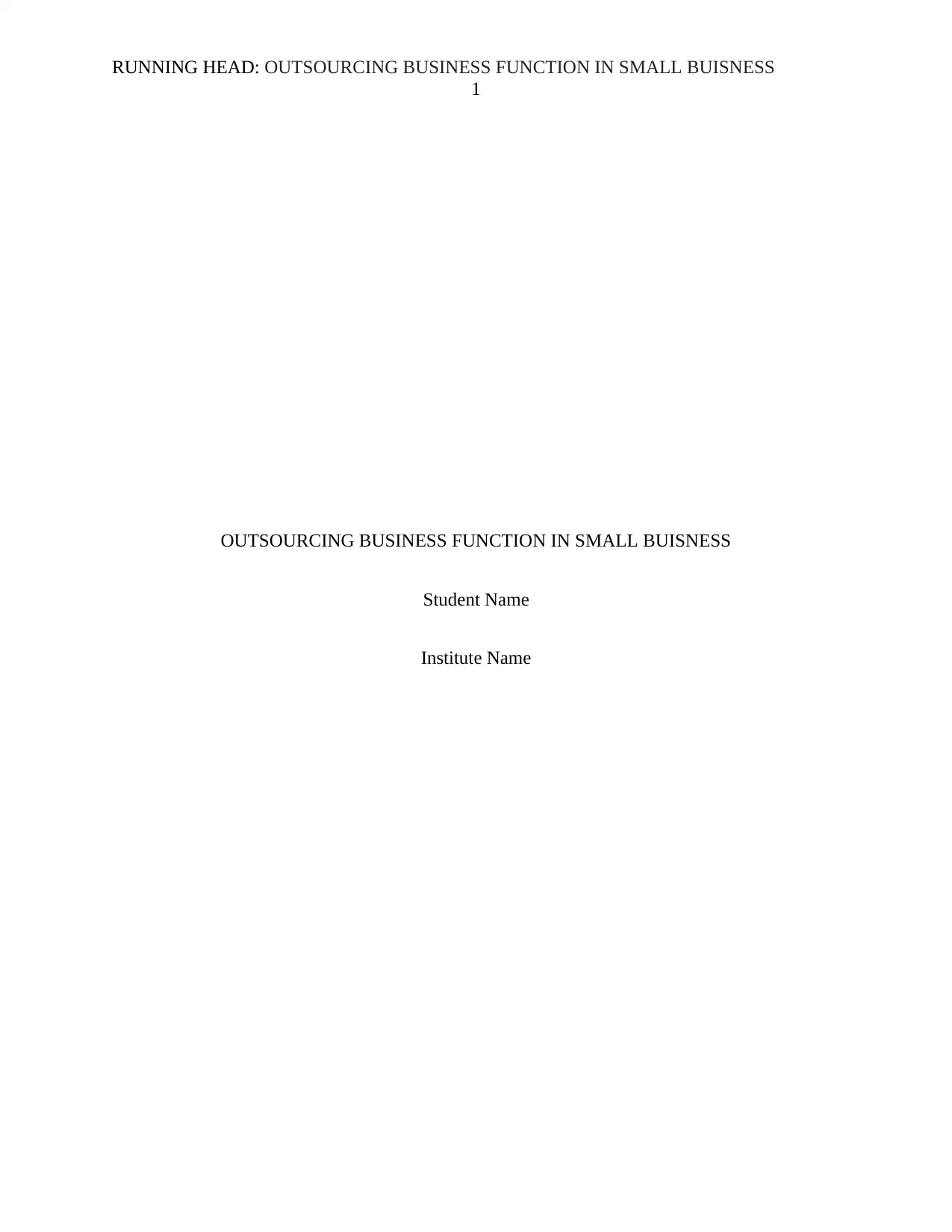
RUNNING HEAD: OUTSOURCING BUSINESS FUNCTION IN SMALL BUISNESS
1
OUTSOURCING BUSINESS FUNCTION IN SMALL BUISNESS
Student Name
Institute Name
1
OUTSOURCING BUSINESS FUNCTION IN SMALL BUISNESS
Student Name
Institute Name
Paraphrase This Document
Need a fresh take? Get an instant paraphrase of this document with our AI Paraphraser
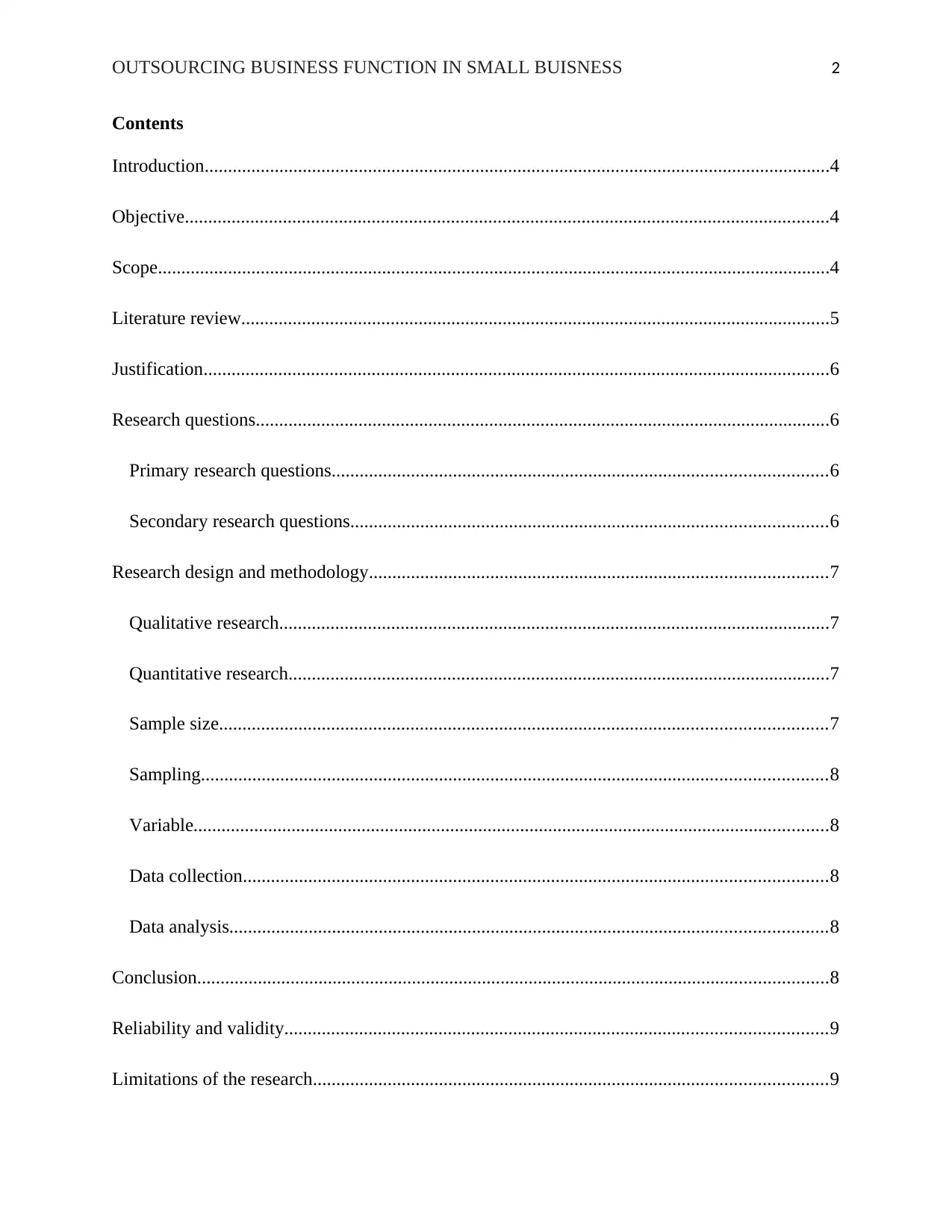
OUTSOURCING BUSINESS FUNCTION IN SMALL BUISNESS 2
Contents
Introduction......................................................................................................................................4
Objective..........................................................................................................................................4
Scope................................................................................................................................................4
Literature review..............................................................................................................................5
Justification......................................................................................................................................6
Research questions...........................................................................................................................6
Primary research questions..........................................................................................................6
Secondary research questions......................................................................................................6
Research design and methodology..................................................................................................7
Qualitative research......................................................................................................................7
Quantitative research....................................................................................................................7
Sample size..................................................................................................................................7
Sampling......................................................................................................................................8
Variable........................................................................................................................................8
Data collection.............................................................................................................................8
Data analysis................................................................................................................................8
Conclusion.......................................................................................................................................8
Reliability and validity....................................................................................................................9
Limitations of the research..............................................................................................................9
Contents
Introduction......................................................................................................................................4
Objective..........................................................................................................................................4
Scope................................................................................................................................................4
Literature review..............................................................................................................................5
Justification......................................................................................................................................6
Research questions...........................................................................................................................6
Primary research questions..........................................................................................................6
Secondary research questions......................................................................................................6
Research design and methodology..................................................................................................7
Qualitative research......................................................................................................................7
Quantitative research....................................................................................................................7
Sample size..................................................................................................................................7
Sampling......................................................................................................................................8
Variable........................................................................................................................................8
Data collection.............................................................................................................................8
Data analysis................................................................................................................................8
Conclusion.......................................................................................................................................8
Reliability and validity....................................................................................................................9
Limitations of the research..............................................................................................................9
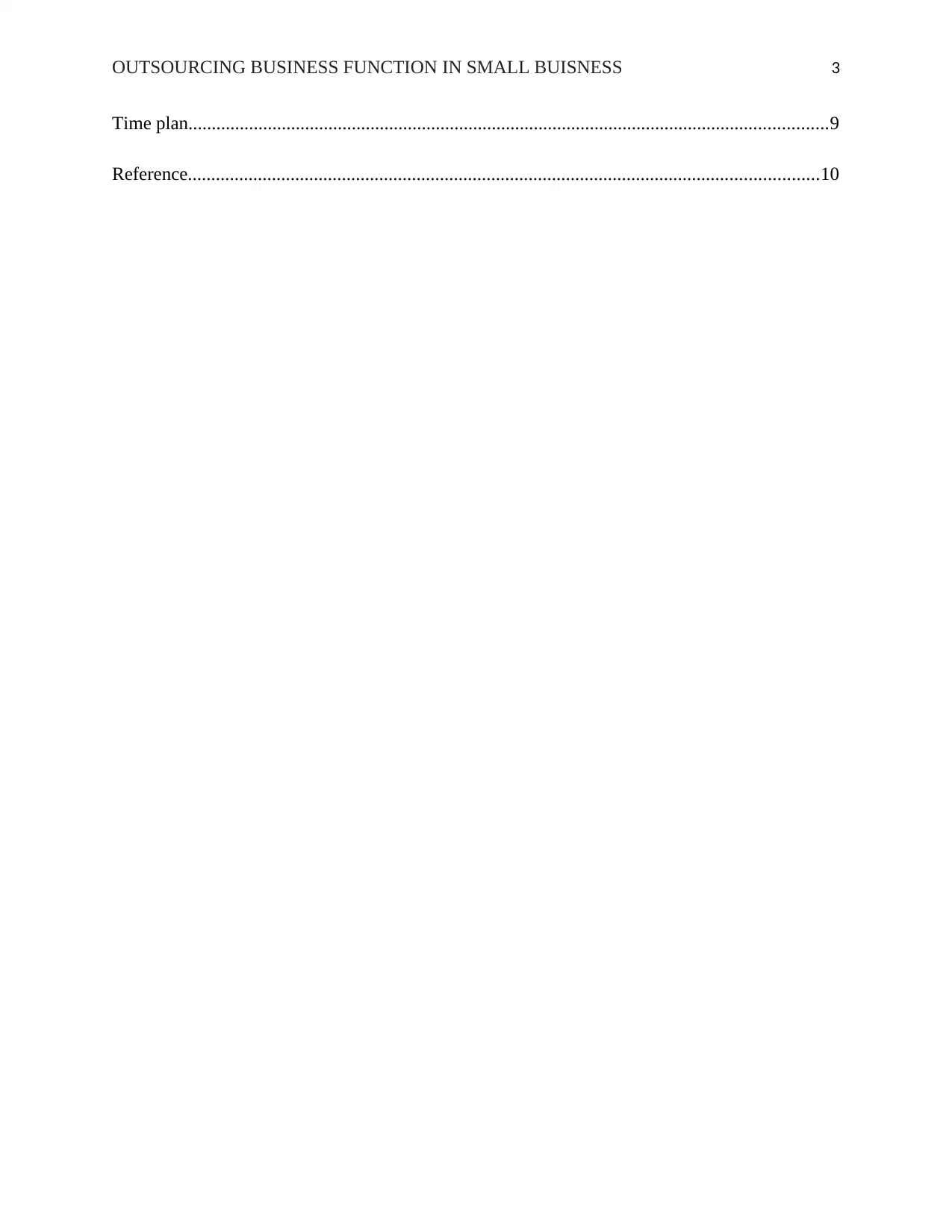
OUTSOURCING BUSINESS FUNCTION IN SMALL BUISNESS 3
Time plan.........................................................................................................................................9
Reference.......................................................................................................................................10
Time plan.........................................................................................................................................9
Reference.......................................................................................................................................10
⊘ This is a preview!⊘
Do you want full access?
Subscribe today to unlock all pages.

Trusted by 1+ million students worldwide
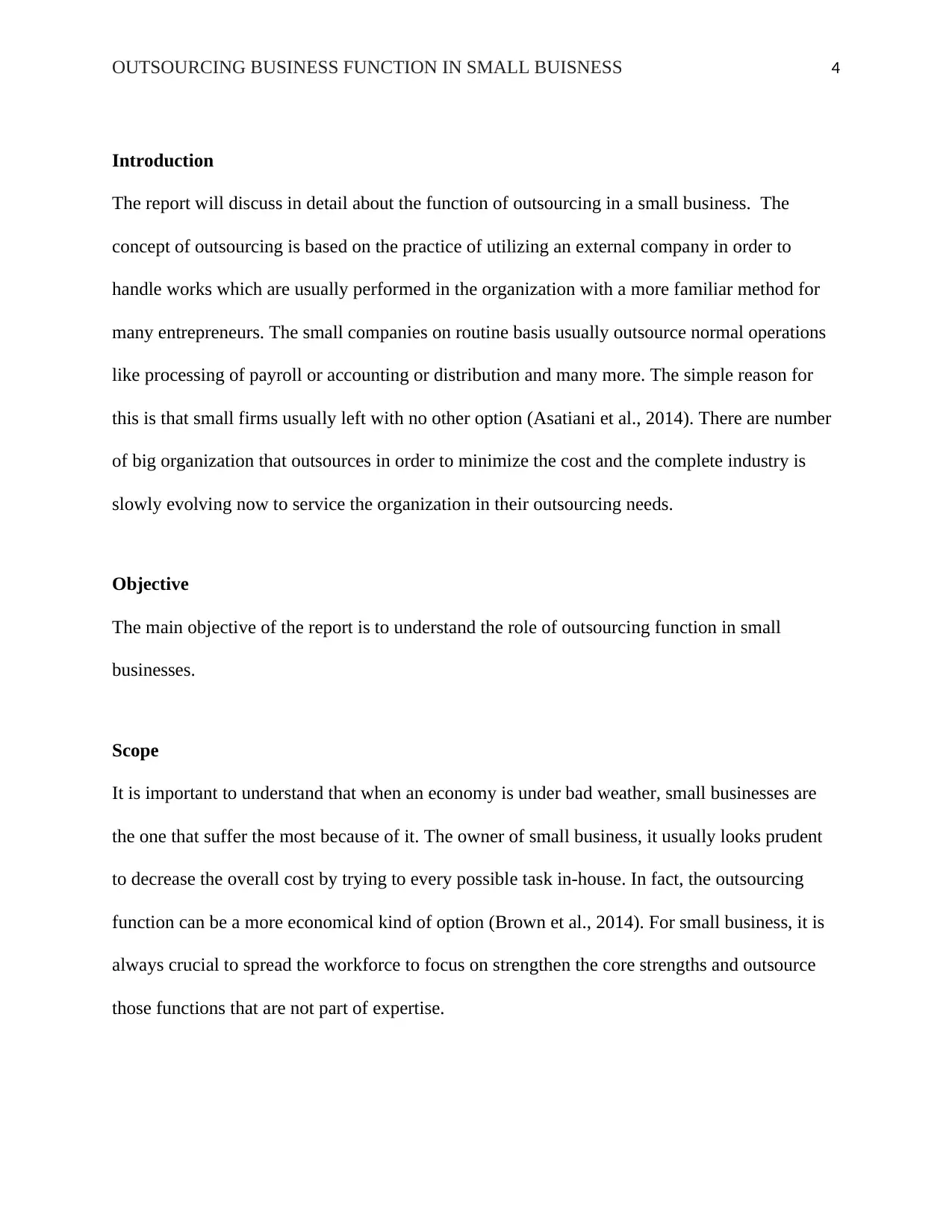
OUTSOURCING BUSINESS FUNCTION IN SMALL BUISNESS 4
Introduction
The report will discuss in detail about the function of outsourcing in a small business. The
concept of outsourcing is based on the practice of utilizing an external company in order to
handle works which are usually performed in the organization with a more familiar method for
many entrepreneurs. The small companies on routine basis usually outsource normal operations
like processing of payroll or accounting or distribution and many more. The simple reason for
this is that small firms usually left with no other option (Asatiani et al., 2014). There are number
of big organization that outsources in order to minimize the cost and the complete industry is
slowly evolving now to service the organization in their outsourcing needs.
Objective
The main objective of the report is to understand the role of outsourcing function in small
businesses.
Scope
It is important to understand that when an economy is under bad weather, small businesses are
the one that suffer the most because of it. The owner of small business, it usually looks prudent
to decrease the overall cost by trying to every possible task in-house. In fact, the outsourcing
function can be a more economical kind of option (Brown et al., 2014). For small business, it is
always crucial to spread the workforce to focus on strengthen the core strengths and outsource
those functions that are not part of expertise.
Introduction
The report will discuss in detail about the function of outsourcing in a small business. The
concept of outsourcing is based on the practice of utilizing an external company in order to
handle works which are usually performed in the organization with a more familiar method for
many entrepreneurs. The small companies on routine basis usually outsource normal operations
like processing of payroll or accounting or distribution and many more. The simple reason for
this is that small firms usually left with no other option (Asatiani et al., 2014). There are number
of big organization that outsources in order to minimize the cost and the complete industry is
slowly evolving now to service the organization in their outsourcing needs.
Objective
The main objective of the report is to understand the role of outsourcing function in small
businesses.
Scope
It is important to understand that when an economy is under bad weather, small businesses are
the one that suffer the most because of it. The owner of small business, it usually looks prudent
to decrease the overall cost by trying to every possible task in-house. In fact, the outsourcing
function can be a more economical kind of option (Brown et al., 2014). For small business, it is
always crucial to spread the workforce to focus on strengthen the core strengths and outsource
those functions that are not part of expertise.
Paraphrase This Document
Need a fresh take? Get an instant paraphrase of this document with our AI Paraphraser
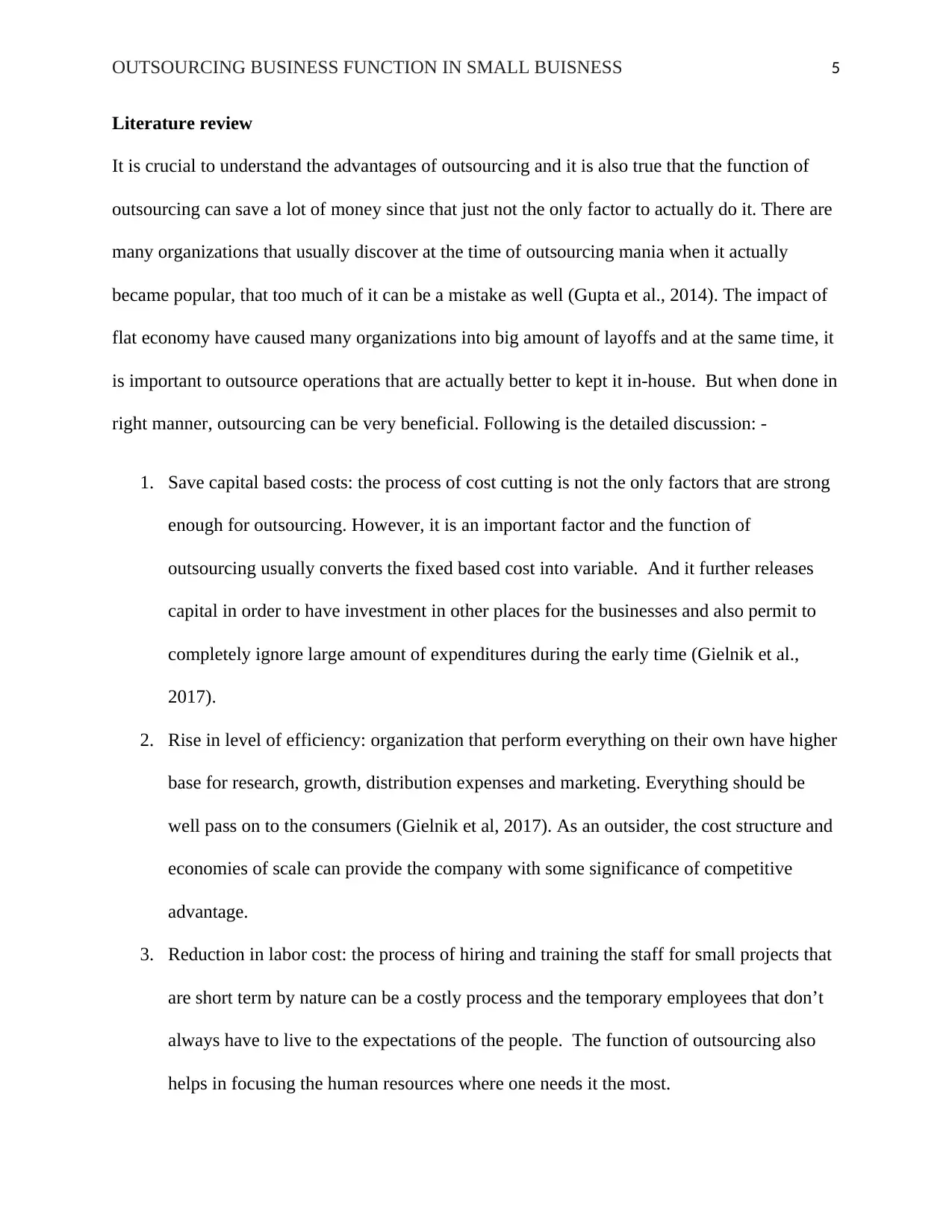
OUTSOURCING BUSINESS FUNCTION IN SMALL BUISNESS 5
Literature review
It is crucial to understand the advantages of outsourcing and it is also true that the function of
outsourcing can save a lot of money since that just not the only factor to actually do it. There are
many organizations that usually discover at the time of outsourcing mania when it actually
became popular, that too much of it can be a mistake as well (Gupta et al., 2014). The impact of
flat economy have caused many organizations into big amount of layoffs and at the same time, it
is important to outsource operations that are actually better to kept it in-house. But when done in
right manner, outsourcing can be very beneficial. Following is the detailed discussion: -
1. Save capital based costs: the process of cost cutting is not the only factors that are strong
enough for outsourcing. However, it is an important factor and the function of
outsourcing usually converts the fixed based cost into variable. And it further releases
capital in order to have investment in other places for the businesses and also permit to
completely ignore large amount of expenditures during the early time (Gielnik et al.,
2017).
2. Rise in level of efficiency: organization that perform everything on their own have higher
base for research, growth, distribution expenses and marketing. Everything should be
well pass on to the consumers (Gielnik et al, 2017). As an outsider, the cost structure and
economies of scale can provide the company with some significance of competitive
advantage.
3. Reduction in labor cost: the process of hiring and training the staff for small projects that
are short term by nature can be a costly process and the temporary employees that don’t
always have to live to the expectations of the people. The function of outsourcing also
helps in focusing the human resources where one needs it the most.
Literature review
It is crucial to understand the advantages of outsourcing and it is also true that the function of
outsourcing can save a lot of money since that just not the only factor to actually do it. There are
many organizations that usually discover at the time of outsourcing mania when it actually
became popular, that too much of it can be a mistake as well (Gupta et al., 2014). The impact of
flat economy have caused many organizations into big amount of layoffs and at the same time, it
is important to outsource operations that are actually better to kept it in-house. But when done in
right manner, outsourcing can be very beneficial. Following is the detailed discussion: -
1. Save capital based costs: the process of cost cutting is not the only factors that are strong
enough for outsourcing. However, it is an important factor and the function of
outsourcing usually converts the fixed based cost into variable. And it further releases
capital in order to have investment in other places for the businesses and also permit to
completely ignore large amount of expenditures during the early time (Gielnik et al.,
2017).
2. Rise in level of efficiency: organization that perform everything on their own have higher
base for research, growth, distribution expenses and marketing. Everything should be
well pass on to the consumers (Gielnik et al, 2017). As an outsider, the cost structure and
economies of scale can provide the company with some significance of competitive
advantage.
3. Reduction in labor cost: the process of hiring and training the staff for small projects that
are short term by nature can be a costly process and the temporary employees that don’t
always have to live to the expectations of the people. The function of outsourcing also
helps in focusing the human resources where one needs it the most.

OUTSOURCING BUSINESS FUNCTION IN SMALL BUISNESS 6
4. Starting the new project rapidly: a good outsourcing company has the right resources in
order to initiate a project. Therefore, in order to handle the same project performed in
house might consist of take a lot of time to hire right kind of people, provide the right
support and train them adequately (Lawrence and Weber, 2014).
Justification
The outsourcing function is an emerging strategic move or trend among many small businesses.
This strategy was previously taken usually by small or large size companies. (Akbari et al., 2016)
The report will review in detail about the academic based journal literature. In alignment of the
mission with small business consider it as a pertinent issue that must be considered with
supervision offered by the owners as well as the managers in small businesses (Hair, 2015).
Research questions
Primary research questions
1. What is significance of outsourcing for small businesses?
Secondary research questions
1. How to start the outsourcing business for small businesses?
2. What are opportunities for outsourcing businesses?
3. What are the disadvantages of outsourcing?
4. Why small businesses should outsource their operations?
4. Starting the new project rapidly: a good outsourcing company has the right resources in
order to initiate a project. Therefore, in order to handle the same project performed in
house might consist of take a lot of time to hire right kind of people, provide the right
support and train them adequately (Lawrence and Weber, 2014).
Justification
The outsourcing function is an emerging strategic move or trend among many small businesses.
This strategy was previously taken usually by small or large size companies. (Akbari et al., 2016)
The report will review in detail about the academic based journal literature. In alignment of the
mission with small business consider it as a pertinent issue that must be considered with
supervision offered by the owners as well as the managers in small businesses (Hair, 2015).
Research questions
Primary research questions
1. What is significance of outsourcing for small businesses?
Secondary research questions
1. How to start the outsourcing business for small businesses?
2. What are opportunities for outsourcing businesses?
3. What are the disadvantages of outsourcing?
4. Why small businesses should outsource their operations?
⊘ This is a preview!⊘
Do you want full access?
Subscribe today to unlock all pages.

Trusted by 1+ million students worldwide
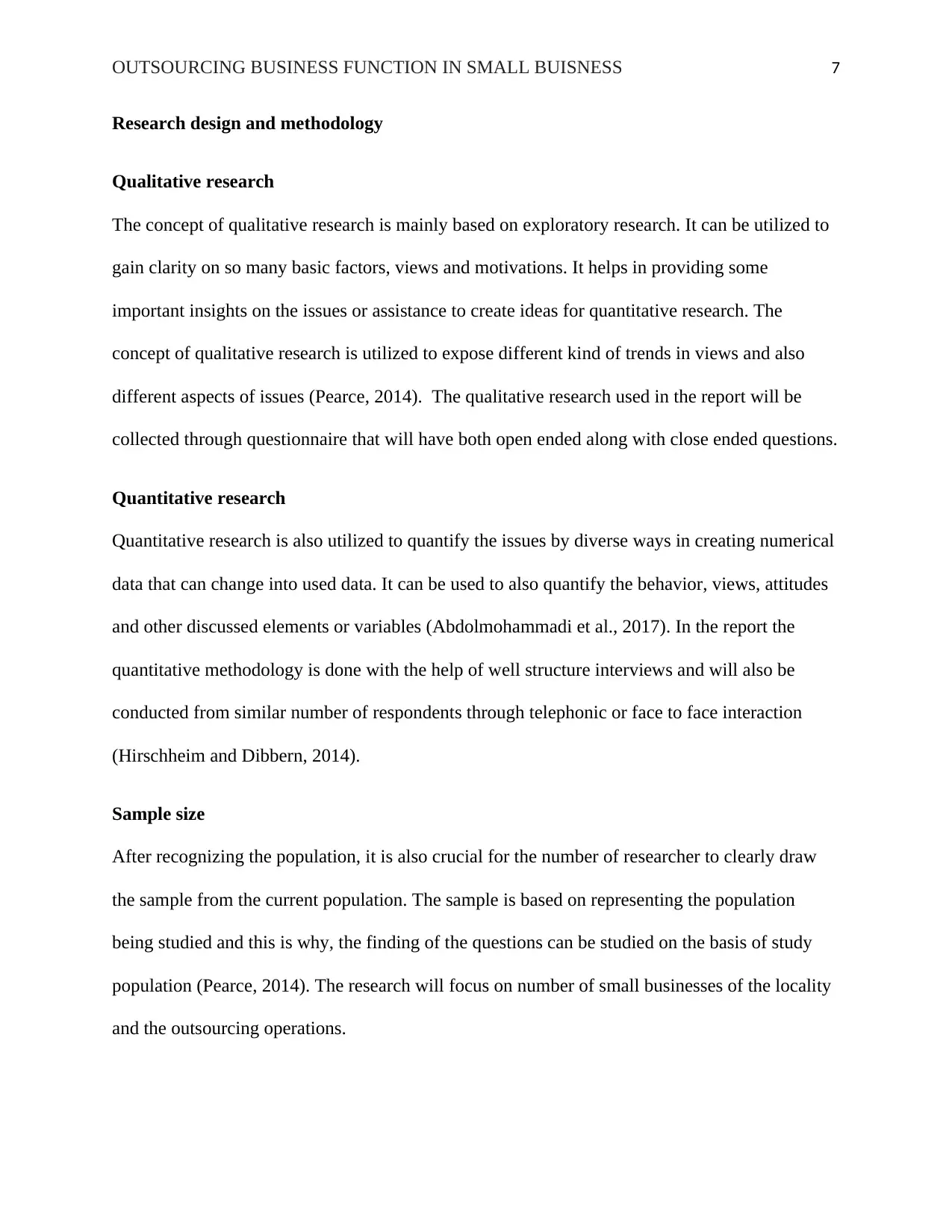
OUTSOURCING BUSINESS FUNCTION IN SMALL BUISNESS 7
Research design and methodology
Qualitative research
The concept of qualitative research is mainly based on exploratory research. It can be utilized to
gain clarity on so many basic factors, views and motivations. It helps in providing some
important insights on the issues or assistance to create ideas for quantitative research. The
concept of qualitative research is utilized to expose different kind of trends in views and also
different aspects of issues (Pearce, 2014). The qualitative research used in the report will be
collected through questionnaire that will have both open ended along with close ended questions.
Quantitative research
Quantitative research is also utilized to quantify the issues by diverse ways in creating numerical
data that can change into used data. It can be used to also quantify the behavior, views, attitudes
and other discussed elements or variables (Abdolmohammadi et al., 2017). In the report the
quantitative methodology is done with the help of well structure interviews and will also be
conducted from similar number of respondents through telephonic or face to face interaction
(Hirschheim and Dibbern, 2014).
Sample size
After recognizing the population, it is also crucial for the number of researcher to clearly draw
the sample from the current population. The sample is based on representing the population
being studied and this is why, the finding of the questions can be studied on the basis of study
population (Pearce, 2014). The research will focus on number of small businesses of the locality
and the outsourcing operations.
Research design and methodology
Qualitative research
The concept of qualitative research is mainly based on exploratory research. It can be utilized to
gain clarity on so many basic factors, views and motivations. It helps in providing some
important insights on the issues or assistance to create ideas for quantitative research. The
concept of qualitative research is utilized to expose different kind of trends in views and also
different aspects of issues (Pearce, 2014). The qualitative research used in the report will be
collected through questionnaire that will have both open ended along with close ended questions.
Quantitative research
Quantitative research is also utilized to quantify the issues by diverse ways in creating numerical
data that can change into used data. It can be used to also quantify the behavior, views, attitudes
and other discussed elements or variables (Abdolmohammadi et al., 2017). In the report the
quantitative methodology is done with the help of well structure interviews and will also be
conducted from similar number of respondents through telephonic or face to face interaction
(Hirschheim and Dibbern, 2014).
Sample size
After recognizing the population, it is also crucial for the number of researcher to clearly draw
the sample from the current population. The sample is based on representing the population
being studied and this is why, the finding of the questions can be studied on the basis of study
population (Pearce, 2014). The research will focus on number of small businesses of the locality
and the outsourcing operations.
Paraphrase This Document
Need a fresh take? Get an instant paraphrase of this document with our AI Paraphraser
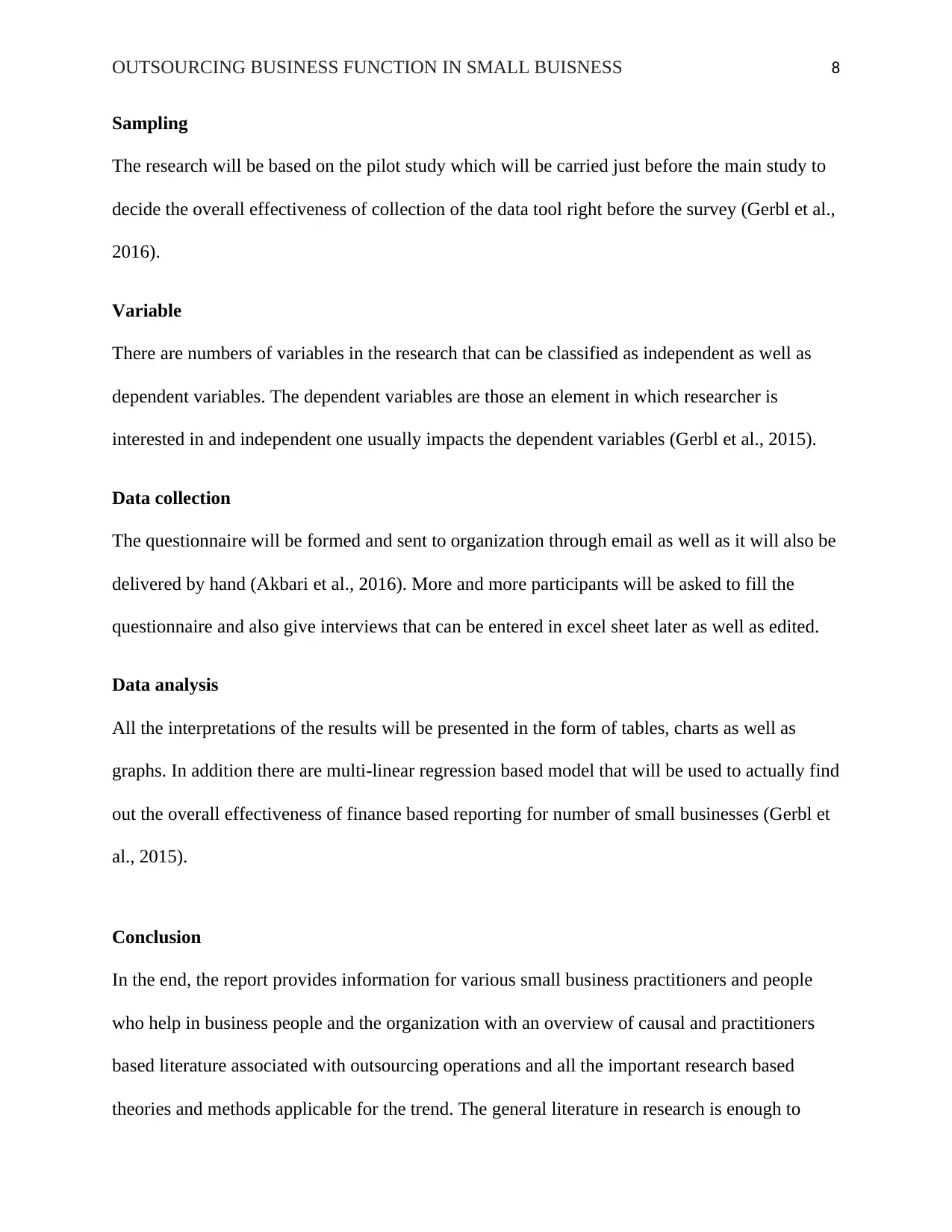
OUTSOURCING BUSINESS FUNCTION IN SMALL BUISNESS 8
Sampling
The research will be based on the pilot study which will be carried just before the main study to
decide the overall effectiveness of collection of the data tool right before the survey (Gerbl et al.,
2016).
Variable
There are numbers of variables in the research that can be classified as independent as well as
dependent variables. The dependent variables are those an element in which researcher is
interested in and independent one usually impacts the dependent variables (Gerbl et al., 2015).
Data collection
The questionnaire will be formed and sent to organization through email as well as it will also be
delivered by hand (Akbari et al., 2016). More and more participants will be asked to fill the
questionnaire and also give interviews that can be entered in excel sheet later as well as edited.
Data analysis
All the interpretations of the results will be presented in the form of tables, charts as well as
graphs. In addition there are multi-linear regression based model that will be used to actually find
out the overall effectiveness of finance based reporting for number of small businesses (Gerbl et
al., 2015).
Conclusion
In the end, the report provides information for various small business practitioners and people
who help in business people and the organization with an overview of causal and practitioners
based literature associated with outsourcing operations and all the important research based
theories and methods applicable for the trend. The general literature in research is enough to
Sampling
The research will be based on the pilot study which will be carried just before the main study to
decide the overall effectiveness of collection of the data tool right before the survey (Gerbl et al.,
2016).
Variable
There are numbers of variables in the research that can be classified as independent as well as
dependent variables. The dependent variables are those an element in which researcher is
interested in and independent one usually impacts the dependent variables (Gerbl et al., 2015).
Data collection
The questionnaire will be formed and sent to organization through email as well as it will also be
delivered by hand (Akbari et al., 2016). More and more participants will be asked to fill the
questionnaire and also give interviews that can be entered in excel sheet later as well as edited.
Data analysis
All the interpretations of the results will be presented in the form of tables, charts as well as
graphs. In addition there are multi-linear regression based model that will be used to actually find
out the overall effectiveness of finance based reporting for number of small businesses (Gerbl et
al., 2015).
Conclusion
In the end, the report provides information for various small business practitioners and people
who help in business people and the organization with an overview of causal and practitioners
based literature associated with outsourcing operations and all the important research based
theories and methods applicable for the trend. The general literature in research is enough to
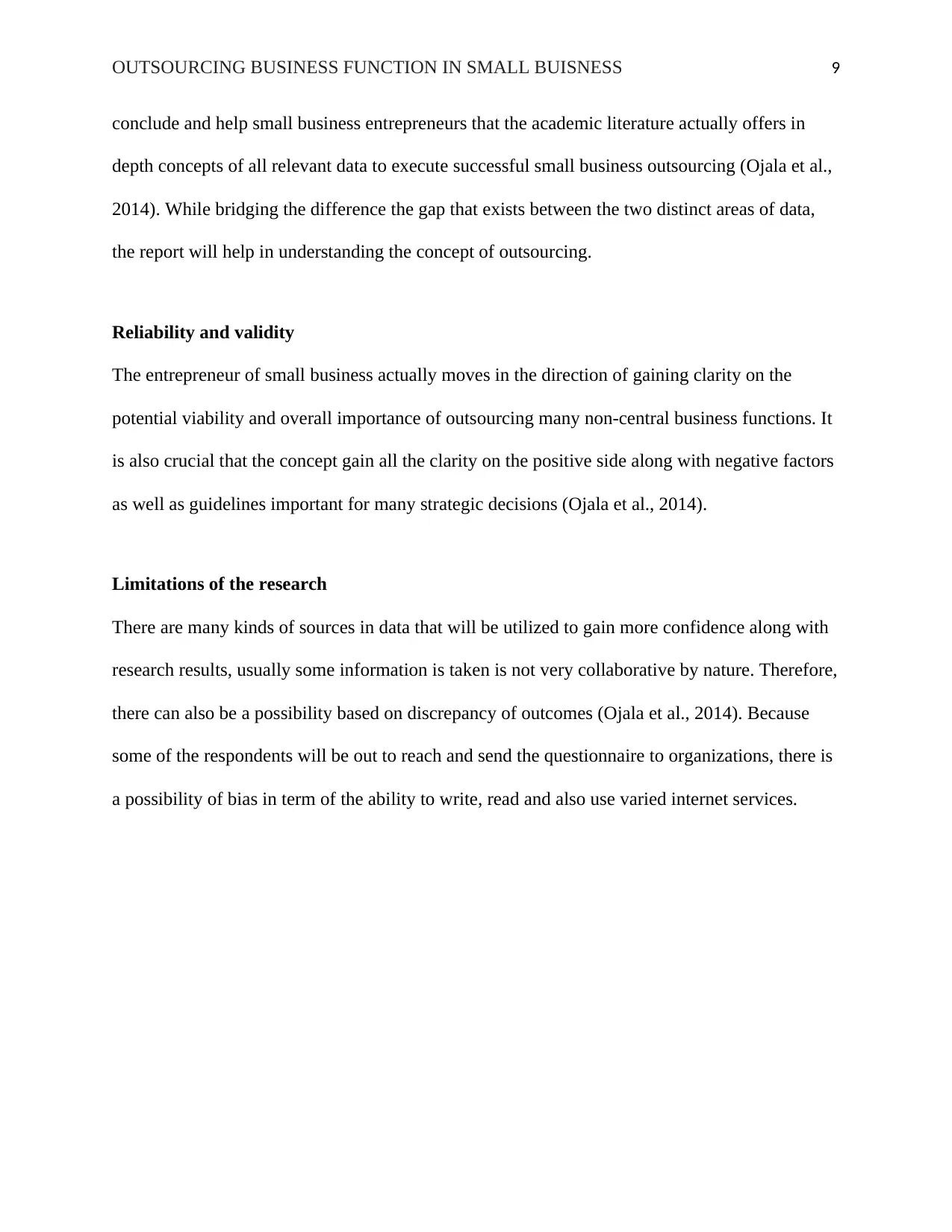
OUTSOURCING BUSINESS FUNCTION IN SMALL BUISNESS 9
conclude and help small business entrepreneurs that the academic literature actually offers in
depth concepts of all relevant data to execute successful small business outsourcing (Ojala et al.,
2014). While bridging the difference the gap that exists between the two distinct areas of data,
the report will help in understanding the concept of outsourcing.
Reliability and validity
The entrepreneur of small business actually moves in the direction of gaining clarity on the
potential viability and overall importance of outsourcing many non-central business functions. It
is also crucial that the concept gain all the clarity on the positive side along with negative factors
as well as guidelines important for many strategic decisions (Ojala et al., 2014).
Limitations of the research
There are many kinds of sources in data that will be utilized to gain more confidence along with
research results, usually some information is taken is not very collaborative by nature. Therefore,
there can also be a possibility based on discrepancy of outcomes (Ojala et al., 2014). Because
some of the respondents will be out to reach and send the questionnaire to organizations, there is
a possibility of bias in term of the ability to write, read and also use varied internet services.
conclude and help small business entrepreneurs that the academic literature actually offers in
depth concepts of all relevant data to execute successful small business outsourcing (Ojala et al.,
2014). While bridging the difference the gap that exists between the two distinct areas of data,
the report will help in understanding the concept of outsourcing.
Reliability and validity
The entrepreneur of small business actually moves in the direction of gaining clarity on the
potential viability and overall importance of outsourcing many non-central business functions. It
is also crucial that the concept gain all the clarity on the positive side along with negative factors
as well as guidelines important for many strategic decisions (Ojala et al., 2014).
Limitations of the research
There are many kinds of sources in data that will be utilized to gain more confidence along with
research results, usually some information is taken is not very collaborative by nature. Therefore,
there can also be a possibility based on discrepancy of outcomes (Ojala et al., 2014). Because
some of the respondents will be out to reach and send the questionnaire to organizations, there is
a possibility of bias in term of the ability to write, read and also use varied internet services.
⊘ This is a preview!⊘
Do you want full access?
Subscribe today to unlock all pages.

Trusted by 1+ million students worldwide
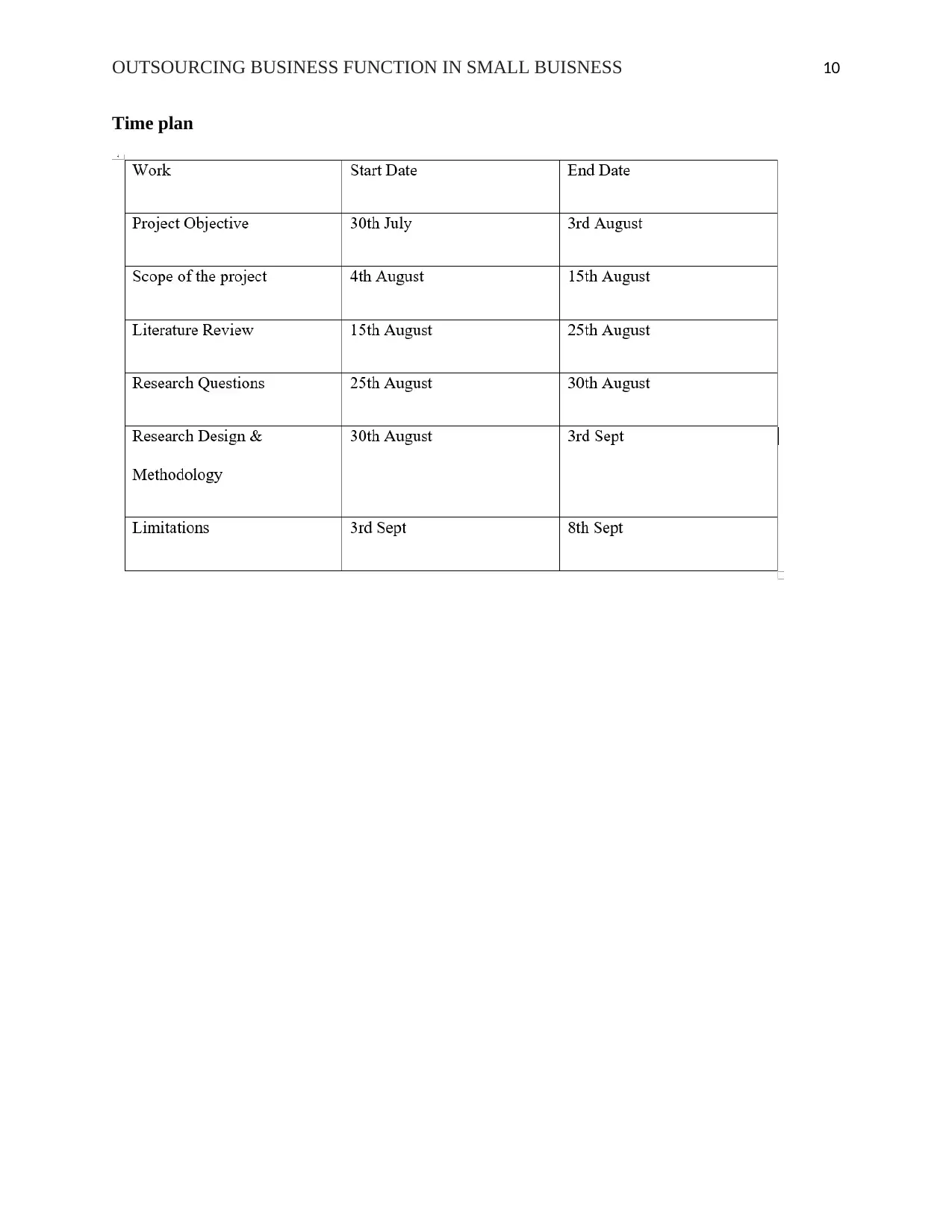
OUTSOURCING BUSINESS FUNCTION IN SMALL BUISNESS 10
Time plan
Time plan
Paraphrase This Document
Need a fresh take? Get an instant paraphrase of this document with our AI Paraphraser

OUTSOURCING BUSINESS FUNCTION IN SMALL BUISNESS 11
Reference
Abdolmohammadi, M.J., DeSimone, S.M., Hsieh, T.S. and Wang, Z., 2017. Factors associated
with internal audit function involvement with XBRL implementation in public companies: An
international study. International Journal of Accounting Information Systems, 25, pp.45-56.
Akbari, M. and Hopkins, J., 2016. The changing business landscape in Iran: establishing
outsourcing best practices. Operations and Supply Chain Management: An International
Journal, 9(3), pp.184-197.
Asatiani, A., Apte, U., Penttinen, E., Rönkkö, M. and Saarinen, T., 2014, January. Outsourcing
of disaggregated services in cloud-based enterprise information systems. In System Sciences
(HICSS), 2014 47th Hawaii International Conference on (pp. 1268-1277). IEEE.
Brown, C., Sturgeon, T. and Lane, J., 2014. Using a business function framework to examine
outsourcing and offshoring by US organizations.
Gerbl, M., Gerbl, M., McIvor, R., McIvor, R., Humphreys, P. and Humphreys, P., 2016. Making
the business process outsourcing decision: why distance matters. International Journal of
Operations & Production Management, 36(9), pp.1037-1064.
Gerbl, M., McIvor, R., Loane, S. and Humphreys, P., 2015. A multi-theory approach to
understanding the business process outsourcing decision. Journal of World Business, 50(3),
pp.505-518.
Reference
Abdolmohammadi, M.J., DeSimone, S.M., Hsieh, T.S. and Wang, Z., 2017. Factors associated
with internal audit function involvement with XBRL implementation in public companies: An
international study. International Journal of Accounting Information Systems, 25, pp.45-56.
Akbari, M. and Hopkins, J., 2016. The changing business landscape in Iran: establishing
outsourcing best practices. Operations and Supply Chain Management: An International
Journal, 9(3), pp.184-197.
Asatiani, A., Apte, U., Penttinen, E., Rönkkö, M. and Saarinen, T., 2014, January. Outsourcing
of disaggregated services in cloud-based enterprise information systems. In System Sciences
(HICSS), 2014 47th Hawaii International Conference on (pp. 1268-1277). IEEE.
Brown, C., Sturgeon, T. and Lane, J., 2014. Using a business function framework to examine
outsourcing and offshoring by US organizations.
Gerbl, M., Gerbl, M., McIvor, R., McIvor, R., Humphreys, P. and Humphreys, P., 2016. Making
the business process outsourcing decision: why distance matters. International Journal of
Operations & Production Management, 36(9), pp.1037-1064.
Gerbl, M., McIvor, R., Loane, S. and Humphreys, P., 2015. A multi-theory approach to
understanding the business process outsourcing decision. Journal of World Business, 50(3),
pp.505-518.

OUTSOURCING BUSINESS FUNCTION IN SMALL BUISNESS 12
Gielnik, M.M., Zacher, H. and Schmitt, A., 2017. How small business managers’ age and focus
on opportunities affect business growth: a mediated moderation growth model. Journal of Small
Business Management, 55(3), pp.460-483.
Gielnik, M.M., Zacher, H. and Schmitt, A., 2017. How small business managers’ age and focus
on opportunities affect business growth: a mediated moderation growth model. Journal of Small
Business Management, 55(3), pp.460-483.
Gupta, A., Carroll, J., Gatti, P. and Greiner, E., 2014. The Perceived Risks of IT Outsourcing: An
Exploratory Comparison of Large MNC & SME’s. Oxford Journal: An International Journal of
Business & Economics, 2(1).
Hair, J.F., 2015. Essentials of business research methods. ME Sharpe.
Hirschheim, R. and Dibbern, J., 2014. Information technology outsourcing: towards sustainable
business value. In Information Systems Outsourcing (pp. 1-19). Springer Berlin Heidelberg.
KATO, A., 2016. The Function and Resilience of Clan Networks in Industrial Districts: Case
Study of the Dies and Molds Industry in East Osaka Area. Organizational Science, 48(5), pp.1-
15.
Lawrence, A.T. and Weber, J., 2014. Business and society: Stakeholders, ethics, public policy.
Tata McGraw-Hill Education.
McIvor, R., 2016. An analysis of the application of process improvement techniques in business
process outsourcing. International Journal of Quality & Reliability Management, 33(3), pp.321-
343.
Gielnik, M.M., Zacher, H. and Schmitt, A., 2017. How small business managers’ age and focus
on opportunities affect business growth: a mediated moderation growth model. Journal of Small
Business Management, 55(3), pp.460-483.
Gielnik, M.M., Zacher, H. and Schmitt, A., 2017. How small business managers’ age and focus
on opportunities affect business growth: a mediated moderation growth model. Journal of Small
Business Management, 55(3), pp.460-483.
Gupta, A., Carroll, J., Gatti, P. and Greiner, E., 2014. The Perceived Risks of IT Outsourcing: An
Exploratory Comparison of Large MNC & SME’s. Oxford Journal: An International Journal of
Business & Economics, 2(1).
Hair, J.F., 2015. Essentials of business research methods. ME Sharpe.
Hirschheim, R. and Dibbern, J., 2014. Information technology outsourcing: towards sustainable
business value. In Information Systems Outsourcing (pp. 1-19). Springer Berlin Heidelberg.
KATO, A., 2016. The Function and Resilience of Clan Networks in Industrial Districts: Case
Study of the Dies and Molds Industry in East Osaka Area. Organizational Science, 48(5), pp.1-
15.
Lawrence, A.T. and Weber, J., 2014. Business and society: Stakeholders, ethics, public policy.
Tata McGraw-Hill Education.
McIvor, R., 2016. An analysis of the application of process improvement techniques in business
process outsourcing. International Journal of Quality & Reliability Management, 33(3), pp.321-
343.
⊘ This is a preview!⊘
Do you want full access?
Subscribe today to unlock all pages.

Trusted by 1+ million students worldwide
1 out of 13
Related Documents
Your All-in-One AI-Powered Toolkit for Academic Success.
+13062052269
info@desklib.com
Available 24*7 on WhatsApp / Email
![[object Object]](/_next/static/media/star-bottom.7253800d.svg)
Unlock your academic potential
Copyright © 2020–2025 A2Z Services. All Rights Reserved. Developed and managed by ZUCOL.





